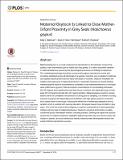Files in this item
Maternal oxytocin is linked to close mother-infant proximity in grey seals (Halichoerus grypus)
Item metadata
| dc.contributor.author | Robinson, Kelly Joanne | |
| dc.contributor.author | Twiss, Sean D. | |
| dc.contributor.author | Hazon, Neil | |
| dc.contributor.author | Pomeroy, Patrick | |
| dc.date.accessioned | 2016-01-13T11:10:07Z | |
| dc.date.available | 2016-01-13T11:10:07Z | |
| dc.date.issued | 2015-12-23 | |
| dc.identifier | 234639449 | |
| dc.identifier | 12dd7bcc-fd87-4df3-aba4-071a5d5631aa | |
| dc.identifier | 84956898195 | |
| dc.identifier | 000367092600024 | |
| dc.identifier.citation | Robinson , K J , Twiss , S D , Hazon , N & Pomeroy , P 2015 , ' Maternal oxytocin is linked to close mother-infant proximity in grey seals ( Halichoerus grypus ) ' , PLoS ONE , vol. 10 , no. 12 , e0144577 . https://doi.org/10.1371/journal.pone.0144577 | en |
| dc.identifier.issn | 1932-6203 | |
| dc.identifier.other | ORCID: /0000-0003-1603-5630/work/46569105 | |
| dc.identifier.other | ORCID: /0000-0002-6212-9710/work/75996841 | |
| dc.identifier.uri | https://hdl.handle.net/10023/8012 | |
| dc.description | The UK’s Natural Environmental Research Council (http://www.nerc.ac.uk/) funded the long term program of research on grey seals at North Rona andthe Isle of May. PPP and SDT were in receipt of NERC grant NE/G008930/1 during the work. This paper formed part of KJR’s PhD funded by the UK Natural Environment Research Council grant NE/H524930/1 and by SMRU Marine (http://www.smru. st-andrews.ac.uk/), St Andrews, UK. | en |
| dc.description.abstract | Maternal behaviour is a crucial component of reproduction in all mammals; however the quality of care that mothers give to infants can vary greatly. It is vital to document variation in maternal behaviour caused by the physiological processes controlling its expression. This underlying physiology should be conserved throughout reproductive events and should be replicated across all individuals of a species; therefore, any correlates to maternal care quality may be present across many individuals or contexts. Oxytocin modulates the initiation and expression of maternal behaviour in mammals; therefore we tested whether maternal plasma oxytocin concentrations correlated to key maternal behaviours in wild grey seals (Halichoerus grypus). Plasma oxytocin concentrations in non-breeding individuals (4.3 ±0.5 pg/ml) were significantly lower than those in mothers with dependent pups in both early (8.2 ±0.8 37 pg/ml) and late (6.9 ±0.7 pg/ml) lactation. Maternal plasma oxytocin concentrations were not correlated to the amount of nursing prior to sampling, or a mother’s nursing intensity throughout the dependant period. Mothers with high plasma oxytocin concentrations stayed closer to their pups, reducing the likelihood of mother-pup separation during lactation which is credited with causing starvation, the largest cause of pup mortality in grey seals. This is the first study to link endogenous oxytocin concentrations in wild mammalian mothers with any type of maternal behaviour. Oxytocin’s structure and function is widely conserved across mammalian mothers, including humans. Defining the impact the oxytocin system has on maternal behaviour highlights relationships that may occur across many individuals or species, and such behaviours heavily influence infant development and an individual’s lifetime reproductive success. | |
| dc.format.extent | 17 | |
| dc.format.extent | 310240 | |
| dc.language.iso | eng | |
| dc.relation.ispartof | PLoS ONE | en |
| dc.subject | QH301 Biology | en |
| dc.subject | NDAS | en |
| dc.subject | NERC | en |
| dc.subject | BDC | en |
| dc.subject.lcc | QH301 | en |
| dc.title | Maternal oxytocin is linked to close mother-infant proximity in grey seals (Halichoerus grypus) | en |
| dc.type | Journal article | en |
| dc.contributor.sponsor | NERC | en |
| dc.contributor.institution | University of St Andrews. School of Biology | en |
| dc.contributor.institution | University of St Andrews. Sea Mammal Research Unit | en |
| dc.contributor.institution | University of St Andrews. Marine Alliance for Science & Technology Scotland | en |
| dc.contributor.institution | University of St Andrews. Scottish Oceans Institute | en |
| dc.contributor.institution | University of St Andrews. Centre for Research into Ecological & Environmental Modelling | en |
| dc.identifier.doi | 10.1371/journal.pone.0144577 | |
| dc.description.status | Peer reviewed | en |
| dc.identifier.grantnumber | NE/G008930/1 | en |
This item appears in the following Collection(s)
Items in the St Andrews Research Repository are protected by copyright, with all rights reserved, unless otherwise indicated.

